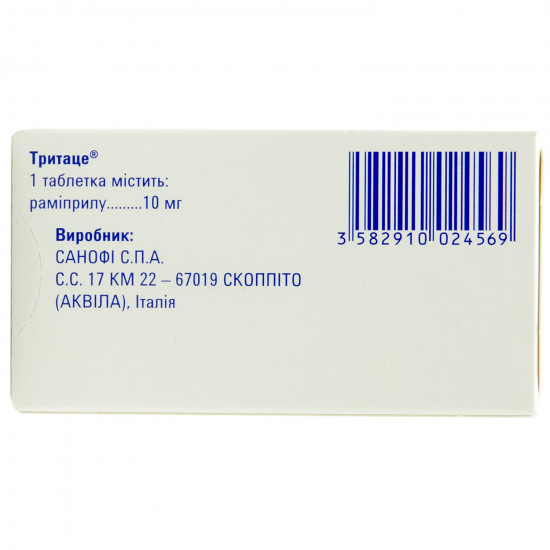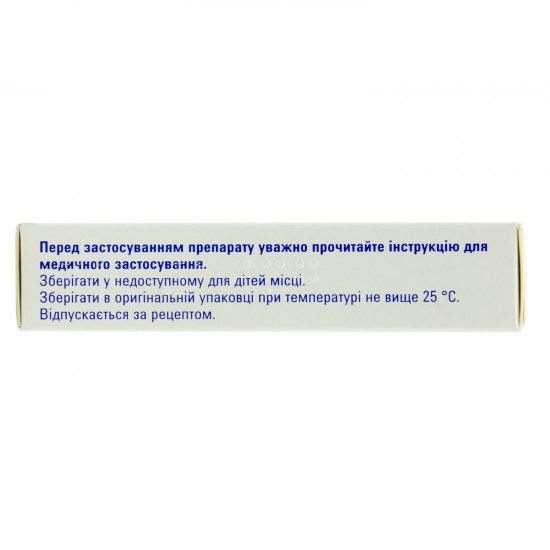





- Stock: In Stock
- Model: 182085
0% Customers recommend this product
-
5 Awesome0%
-
4 Great0%
-
3 Average0%
-
2 Bad0%
-
1 Poor0%
Reviews Over To Tritatsa of the tab. of 10 mg No. 28
- (0)
Total Reviews (0)
click here write review to add review for this product.
Report this review.
Description
Pharmacological properties
Pharmacodynamics
action Mechanism. Ramiprilat, an active metabolite of a ramipril, inhibits enzyme to a dipeptidilkarboksipeptidaz of I (synonyms: angiotensin-converting enzyme; kininaza of II). In blood plasma and fabrics this enzyme catalyzes transformation of angiotensin I to active vasoconstrictive agent (vasoconstrictor) angiotensin II and also disintegration of an active vazodilatator of bradykinin. Decrease in formation of angiotensin II and inhibition of disintegration of bradykinin leads to expansion of blood vessels.
As angiotensin II also stimulates withrelease of Aldosteronum, owing to action of the ramiprilat the secretion of Aldosteronum decreases. Growth of activity of bradykinin, obviously, defines cardiotyre-tread and endotelioprotektorny effects which were observed in experiments on animals. For today it is not established as far as it influences development of certain side effects (for example the irritating cough).
APF Inhibitors are effective even for patients with hypertensia who have a concentration of renin in blood plasma low. The average response to monotherapy by APF inhibitor at patients of negroid race (usually in population with hypertensia and low concentration of renin) was lower in comparison with representatives of others Russ.
Pharmacodynamics
Antihypertensive properties. Use of a ramipril causes noticeable decrease in resistance of peripheral arteries. Generally the renal plazmotok and the glomerular filtration rate (GFR) significantly do not change.
Purpose of a ramipril to patients with AG leadsto decrease in the ABP as in horizontal, and vertical position of the patient, without the compensatory growth of ChSS.
At most of patients the antihypertensive effect occurs in 1–2 h after reception of a single dose. The maximum effect after reception of a single dose usually occurs in 3–6 h. The antihypertensive effect after reception of a single dose usually remains during 24 h
At long-term treatment using a ramipril the maximum antihypertensive effect develops in 3–4 weeks. It is proved that at long therapy the antihypertensive effect remains within 2 years.
Sudden termination of reception of a ramipril does not cause fast and excessive increase in the ABP (ricochet phenomenon).
Heart failure. It is proved that applied as addition to traditional therapy with diuretics and if necessary — cardiac glycosides ramiprit is effective for patients with heart failure of the II-IV functional classes on NYHA. Drug makes favorable impact on a warm hemodynamics (decrease in the ABP, filling of the left and right ventricles, OPSS, increase in warm emission and improvement of cardiac index). It also reduces neuroendocrinal activation.
byClinical performance and safety
Prevention of cardiovascular diseases / nefroprotektsii
carried out preventive placebo - the controlled research (research HOPE) with participation more than 9200 patients who in addition to standard therapy received was ramiprit. Patients with high risk of developing of a cardiovascular disease after the postponed aterotrombotichesky cardiovascular disease (existence in the anamnesis of an ischemic heart disease, a stroke or disease of peripheral vessels) or patients with diabetes participated in this research, had at least one more accessory factor of risk (the microalbuminuria, AG, the increased level of the general XC, XC LDL or smoking is documented).
It is a research showed that ramiprit statistically authentically reduces the frequency of developing of a myocardial infarction, cardiovascular death and a stroke as separately, and in a combination (primary combined final point).
Research HOPE: main results
| Indicator | Ramipril | Placebo | Relative Risk (RR) (95% the confidence interval (CI)) | p |
| % | % | |||
| All patients | n=4.645 | n=4.652 | ||
| Primary combined final point | 14 | 17.8 | 0.78 (0.7-0.86) | 0.001 |
| Myocardial infarction | 9.9 | 12.3 | 0.80 (0.7-0.9) | 0.001 |
| Cardiovascular death | 6.1 | 8.1 | 0.74 (0.64-0.87) | 0.001 |
| Stroke | 3.4 | 4.9 | 0.68 (0.56-0.84) | 0.001 |
| Secondary final points | ||||
| Death for any reason | 10.4 | 12.2 | 0.84 (0.75-0.95) | 0.005 |
| Need for revascularization | 16.0 | 18.3 | 0.85 (0.77-0.94) | 0.002 |
| Hospitalization concerning unstable stenocardia | 12.1 | 12.3 | 0.98 (0.87-1.1) | It is doubtful |
| Hospitalization concerning heart failure | 3.2 | 3.5 | 0.88 (0.7-1.1) | 0.25 |
| Complication, connected with diabetes | 6.4 | 7.6 | 0.84 (0.72-0.98) | 0.03 |
during the research MICRO-HOPE which carrying out was previously planned within the research HOPE, studied the effect arising at addition of a ramipril in a dose of 10 mg to the existing scheme of treatment in comparison with placebo at 3577 patients aged from 55 years (upper age restriction was not) with the normal or raised ABP, the majority of whom with diabetes of the II type (and had at least one factor of cardiovascular risk).
Results of primary analysis showed that at 117 (6.5%) ramiprit the participants of a research receiving, and at 149 (8.4%), the receiving placebos, the expressed nephropathy developed that corresponds to decrease in RR by 24%; 95% of DI 3-40; p=0.027.
Research
Specifications
| Characteristics | |
| Active ingredients | Ramipril |
| Amount of active ingredient | 10 mg |
| Applicant | Sanofi |
| Code of automatic telephone exchange | C09AA05 Ramipril |
| Interaction with food | It doesn't matter |
| Light sensitivity | Not sensitive |
| Market status | Original |
| Origin | Chemical |
| Prescription status | According to the prescription |
| Primary packing | blister |
| Producer | S.P. SANOFI. AND |
| Quantity in packing | 28 tablets (2 blisters on 14 pieces) |
| Release form | tablets for internal use |
| Route of administration | Oral |
| Sign | Import |
| Storage temperature | from 5 °C to 25 °C |
| Trade name | To Tritatsa |

















































